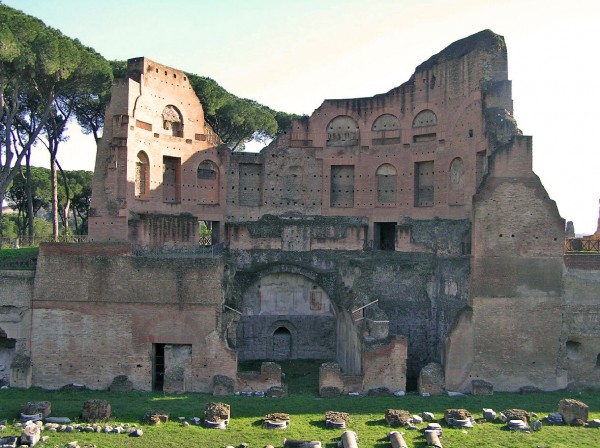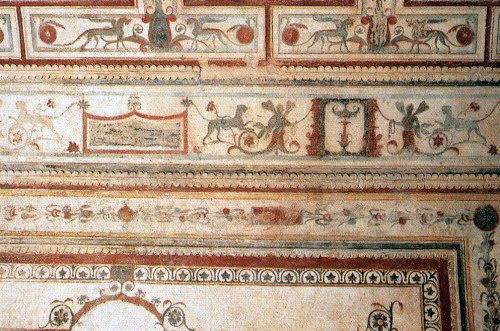
After many year of excavation and restoration, Nero’s golden palace , the Domus Aurea was opened again to the public.
The brick palace was covered with ornate golf leaf which gave it the name the Domus Aurea. Not only did Nero build this massive palace along the slopes of the Palatine, Esquiline and Caelian hills, he also created a man made lake for him to gaze out at. The lake was later drained to make room for the Colosseum, which still stands today.
Domus Aurea was built to be a party house with 300 party rooms. No expense was spared to entertain Nero and his guests. We heard stories of the fabled eight-sided rotating reception hall. The architects of the Domus Aurea developed an innovative mechanism cranked by slaves. And as the ceiling turned, perfume was sprayed and rose petals were dropped on the diners. Legend has it there were so many rose petals falling at one dinner that one of the guests was asphyxiated.
All of the walls were painted with frescos or covered with mosiacs. The head designer “Fabulus” ( how appropriate) moved away from the reds and ochres Rome was so fond of and gave the Domus Aurea a cleaner look using a lot of white wall with ornate accents. The guests were greeted at the entrance by a 120′ tall bronze statue of Nero. The people of Rome referred to the statue as the “Colosseo”. When the statue was torn down and the amphitheatre was built in the same location, the name was still used. Afterall, they were both pretty colossal.
Supposedly upon the completion of the Domus Aurea, Nero exclaimed, “at last, I can finally live like a human”. But soon after it’s completion, Nero was forced into exile and eventually committed suicide, his successors stripped out all of the wealth and memories. They just wanted his reign to disappear. Within 40 years, the Domus Aurea was buried under the construction of the Baths of Trajan.
 The Palace was lost until the late 14th century when a young Roman was walking on the slope of the Esquiline hill and fell through a weak opening. There he was, face to face with some of the most spectacular frescos of ancient Rome, preserved in their burial vault. Pretty soon artists like Pinturicchio, Raphael and Michelangelo were lowering themselves into the shafts to see the great examples of the ancient treasures. The art of Fabulus became known as grotesque because of it’s origins in the grottos of Domus Aurea and the syle once again became the part of the new fashion of the 16th century. Panels of the loggia at the Vatican feature grotesque designs by Raphael. So did Pinturicchio’s cathedral library ceilings at Siena, Perugino’s ceiling of the Cambio in Perugia and even Visari’s ceiling of the Uffizi galleries in Florence.
The Palace was lost until the late 14th century when a young Roman was walking on the slope of the Esquiline hill and fell through a weak opening. There he was, face to face with some of the most spectacular frescos of ancient Rome, preserved in their burial vault. Pretty soon artists like Pinturicchio, Raphael and Michelangelo were lowering themselves into the shafts to see the great examples of the ancient treasures. The art of Fabulus became known as grotesque because of it’s origins in the grottos of Domus Aurea and the syle once again became the part of the new fashion of the 16th century. Panels of the loggia at the Vatican feature grotesque designs by Raphael. So did Pinturicchio’s cathedral library ceilings at Siena, Perugino’s ceiling of the Cambio in Perugia and even Visari’s ceiling of the Uffizi galleries in Florence.
The Domus became a tourist attraction and the likes of Casanova and the Marquis de Sade left their signatures on the walls next to the frescoes. The famous statue of the Laocoön and His Sons, now on display in Vatican, was supposedly discovered in the ruins of the Domus Aurea. By the time we got there, most of the frescoes were gone. The underground moisture finally got to them. All that remained were the brick arches.
Post script – The Domus Aurea closed down again in 2005. Too many ceilings were caving in from the moisture. The Palace is still mostly underground. In 2007, parts were re-opened, but not as much as we were allowed to see in 2000.
You must be logged in to post a comment.